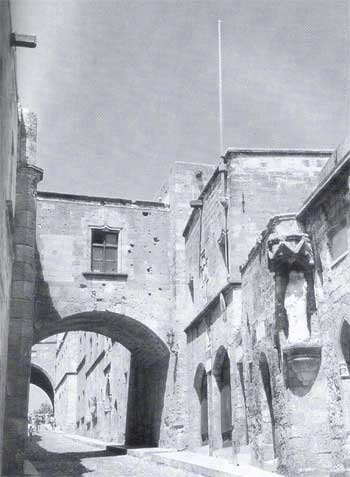|
point in the decades before 1206 the Order's military brethren
were divided into two separate classes, the milites or knights
and the military sergeants(13).
Hospitallers and Templars were not monks,
since they did not live in a closed or cloistered community
or devote themselves primarily to prayer; liturgically they
followed the canonical ordo of seven hours rather than the
monastic ordo of nine hours. They were religious who professed
the vows of poverty, chastity and obedience according to a
Rule approved by the papacy. They took part in many crusades
of a certain type but not, technically, as crusaders. The
crusade was a holy war but it was not perpetual; it took place
for a limited period when, and only when, the pope proclaimed
it; it might be directed against the infidel, or against schismatic
Christians or, as in the majority of cases, against Latins
who were enemies of the papacy. A man who took the vow of
the cross could perform his crusading service, receive his
indulgence and return to normal life. By contrast, the holy
war of the military order was perpetual; it was directed exclusively
against infidels rather than Christians; and it did not depend
on any papal proclamation. A Hospitaller was not a crusader;
he had taken a vow of obedience and was therefore not free
to take the crusader vow; the cross on his habit was worn
in remembrance of Christ's suffering and was not a crusading
cross. The Hospitaller's participation in a crusade was not
that of a crusader (14).
The charitable institution which emerged
from the Jerusalem hospital became, alongside the Templars,
a great force in the Latin East, in its political affairs,
its military expeditions and within its society as a whole.
Its Eastern operations may at times have produced some wealth
for the Hospital in the Levant, especially if it could profit
from the Oriental spice trade or from local sugar production
(15). Basically, however, the Order
relied on the Latin West for manpower, for funds and for political
support. In Western Europe came donations, privileges and
exemptions. Lands were organized in commanderies, priories
and provinces which recruited men and sent them to Syria and
which created wealth and transferred it as responsiones or
dues to the Convent in the East. The commandery had many functions:
it was a centre of liturgical life; it managed estates
to create surplus wealth; it recruited and trained brethren
and it housed them in their old age; it maintained, in certain
places, hospices, hospitals and parishes; and it played a
part in local society, maintaining contact with, and securing
support from, the public as a whole. Commanderies and priories
varied greatly; in some regions the priories' estates and
resources were very extensive indeed (16).
|
Along with
a great expansion in the Hospital's power and importance came
a change in its leadership. The Templars had from their foundation
been knights, some from leading families, but the social origins
of the earliest Hospitallers were obscure and only a limited
number of the Hospital's brethren were fratres milites. There
was great diversity between the priories and it was, in any
case, extremely difficult to define a secular miles or knight.
The 1206 statutes distinguished between milites and the socially
inferior and normally less wealthy sergeants, and they referred
to the knighting of sons of gentilz homes. Thirteenth-century
statutes spoke not of nobility but of the obligation that a
brother-knight be a knight before being received into the Order
or, if he were not yet knighted, that he be of knightly birth
(17). By the mid-fourteenth century
a knight-brother was supposed to be noble through both parents
(18) but in practice many were country
gentry or belonged to an urban patriciate of rich townsmen who
may indeed have claimed a form of nobility or at least of knighthood.
In addition to the three categories of priest-brethren, milites
and sergeants, there were also Hospitaller sisters whose numbers
were not inconsiderable. For example, in England in 1338 there
were approximately 116 professed brethren plus a few more on
Rhodes or elsewhere, and they included 31 milites, almost all
of them from relatively obscure families, 34 priests, 47 sergeants
and also 50 sorores; of these, seventeen sergeants and six priests
held commanderies (19). The sisters
did not fight or serve in hospitals or hospices and they seldom
paid responsiones or attended chapters, but they could be important
in maintaining the Hospital's contacts with noble or gentry
families who provided donations or recruits for the Order.
 |
| Rodi. La "Via dei
Cavalieri". |
|
|
[13]Cartulaire,
i, no. 527.
[14] A. Luttrell, "The Military Orders: Some Definitions",
in Militia Sancti Sepulcri, ed. K. Elm - C. Fonseca (Vatican, 1998);
for a different emphasis, J. Sarnowsky, "Der Johanniterorden
und die Kreuzzuge", in Vita Religiosa in Mittelalter: Festschrift
für Kaspar Elm zum 70. Geburtstag, ed. J. Felten - N. Jaspert
(Berlin, 1999). Technically the Hospitallers were not monks, not
crusaders, not Vasalli Christi and not members of a chivalric order,
whose members were not professed religious; nor were most of them
knights.
[15] A large quantity of the special pottery used in sugar
production has recently been discovered in the excavations of the
Hospital's great palace at Acre.
[16] Most priories have been neglected by historians, some
having lost their archives; they require much more study.
[17] Cartulaire, ii, nos. 1143 (pp. 39-40), 3039 # 19 (1262);
the precise dating of these statutes is open to debate.
[18] A. Luttrell, The Hospitallers in Cyprus, Rhodes, Greece
and the West: 1291-1440 (London, 1978), item XIV, 511.
[19] L. Larking, The Knights Hospitallers in England being
the Report of Prior Philip de Thame to the Grand Master Elyan de
Vilanova for A.D. 1338 (London, 1857), provides slightly imprecise
statistics, some brethren being of uncertain status; these are discussed
in G. O'Malley, The English Knights Hospitallers:
1468-1540 (unpublished Ph.D. thesis: Cambridge, 1999), 27-28.
|
|